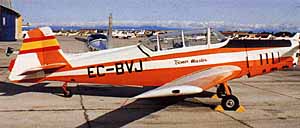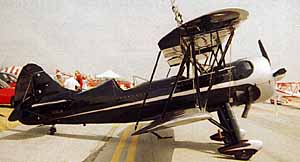
Zlin
326 was one of the first of the modern aerobatic monoplanes.
|
In the mid-1950s,
the pilots of what was then Czechoslovakia introduced a maneuver
during the Lockheed Trophy that they called a "Lomcevak." The
name is variously translated as "log in the head," "headache,"
or "look at that drunk trying to walk," depending on which Czech
you talk to.
Regardless
of the exact translation, the new maneuver blew the assembled
aerobatic community away. It was the first gyroscopic maneuver
to be done, and arguably, it remains the most spectacular.
Gyroscopic
maneuvers are maneuvers that take full or partial advantage of
the gyroscopic precession generated by the spinning propeller.
The pilot usually applies the controls in such a fashion as to
maximize this force, and then basically becomes a spectator until
the energy of the tumble dissipates and it is time to recover
the aircraft.
The classic
Lomcevak is entered from a 45° up line, at cruise speed or
below, with full throttle applied. To begin the maneuver, full
right rudder is applied and held simultaneously with full left
aileron and full down elevator. The response varies considerably
from aircraft to aircraft, but the usual result is a graceful
end-for-end tumble on all three control axes, finishing with the
aircraft in an inverted spin.
The first
postwar, modern-format World Championships (and the first to be
sanctioned by the FAI) was held in Czechoslovakia in 1960. A lone
American participated—Frank Price, who funded himself out
of his own pocket.
In 1962,
American competition aerobatics got a big boost when the Aerobatic
Club of America (later to be superseded by the IAC) organized
and held the first official US National Aerobatic Championships,
held in Phoenix, Arizona. It was won by the legendary Duane Cole,
who had helped to organize the event.
|

The
Stephens A-kro inspired the present generation of Unlimited
monoplanes such as Laser 200, Extra 230, and Superstar.
|
America
sent its first team—a three-man crew consisting of Duane
Cole, Lindsey Parsons, and Rod Jocelyn to the 1962 World Championships
in Budapest, Hungary. Lindsey Parsons placed a very respectable
fifth in his outmatched and underpowered Great Lakes biplane,
beating a considerable number of hot Zlin and Yak monoplanes.
American teams have been a fixture and have been among the top
competitors at every World Championships since.
The next
major development in formal aerobatics was the introduction of
rhe Aresti aerobatic shorthand and scoring system, which was the
contribution of a flamboyant Spanish aerobatic aristocrat. Count
Jose Louis Aresti.
Reportedly,
the Count started out by merely scribbling line diagrams of his
sequence and raping them to his instrument panel as reminders
he could actually read while pulling six or seven Gs. Known merely
as the Sistema Aresti, the notation was first used formally at
the FAI World Championships in 1964. Aresti notation evenrually
evolved into the FAI Aerobatic Catalog, which is today's undisputed
last word on aerobatic figures and families.
Aresli notation
was the final key to the worldwide standardization and evaluation
of formal aerobatic flight. The AMA Competition Regulations includes
examples of Aresti notation by neccesity-the AMA Scale Aerobatics
events are based on it.
Informal
aerobatic flight, as practiced at air shows and freestyle events,
continued (and continues) to resist all attempts at standardization.
and even most attempls at description.
As a result.
the progression of aerobatics in the postwar era has continued
along the same dual track as before the war, with the geometric
progression of the rigorous competition approach on the one hand,
and the spectacular but less-defined air show approach on the
other. The only difference is that the former separation by continent
has disappeared. and both forms of aerobatics are now flown and
enjoyed all over the world.
Around 1972,
American and world aerobaric chanmpion and well-known air show
pilot Charlie Hillard invented the Torque Roll, which basically
consists of entering what looks like a Tail Slide, and then hanging
the aircraft on the prop while initiating a continuous roll to
the left. With a right-turning propeller, engine torque keeps
thc roll going until the aircraft hegins to slide back, whereupon
aileron is immediately reversed (because the direction of flight
is now reversed) to keep the left roll going. Recovery is accomplished
by closing the throttle and finishing as in the Tail Slide.
|

Highly
modlfied WACO known on the airshow circuit as the Mystery
Ship. Note the wing-walker rig projecting fram the top wing.
|
The Zwilbelturm, or Spiral Tower was invented in 1974 by Swiss
and European champion Eric Muller. From a right roll on a vertical
up line, a tumble is begun that resembles an inverted ascending
spin. The controls are reversed to accomplish a transition to
an upright flat spin as the aircraft reaches apogee and starts
to descend.
In the mid-1970s,
heavier aircraft with more powerful engines (more inertia and
more precessive force) lit an explosion in tumbling maneuvers
that continues to the present day. The variations are apparently
endless; so much so that people have either given up on naming
them all, or simply can't remember what it is that they just did
because of the brain-scrambling effects of high-G.
With the
demise of the Lockheed Trophy and the rise of more formally judged
competitions, the primary focus in competition aerobatics shifted
back to the European prewar emphasis on flying standardized figures
with geometric precision.
This competitive
paradigm shift excluded gyroscopic figures such as the Lomcevak,
since aircraft (and pilot) response varies so much that establishing
precise judging standards for tumbling maneuvers is impossible.
(Simply describing some of the figures in Aresti environ is impossible!)
However,
the gyroscopic tumbles and Torque Rolls were far too popular with
competition pilots and spectators to simply be discarded or relegated
to noncompetitive venues. They became the centerpiece of the modern
Four-Minute Freestyle event (which is judged by standards similar
to those used by the Lockheed Trophy), and remain the cutting
edge of aerobatics, where today's pioneers may still discover
new forms of aerobatic flight.
If aeromodeling
has taken much from full-scale aerobatics, it may now he in the
process of giving something back. Many full-scale competition
and air show pilots have participated as performers, or judges
at the well-known Tournament of Champions in Las Vegas, and most
have come away entranced and impressed with the inventiveness
displayed by the pilots during lhe Four-Minute Free.
It is safe
to assume rhat if any of those spectacular 3-D TOC moves are even
possible with a full-scale piloted aircraft, they will be coming
soon to an air show near you—down low, at show center, with
smoke on!
|
|